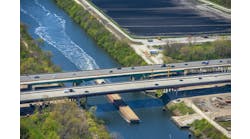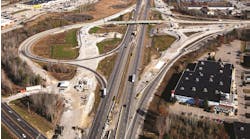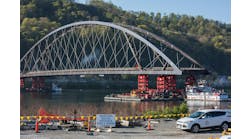PROJECT: Charlotte Outer Loop (I-85/485 interchange and I-85 widening)
LOCATION: Charlotte, N.C.
OWNER: North Carolina DOT
DESIGNERS: STV, Ralph Whitehead Associates, HDR Engineering
CONTRACTOR: Lane Construction
COST: $155 million
START DATE: Spring 2011
COMPLETION DATE: Late summer 2014
Midnight oil does not have to be purchased years in advance. It’s on hand when you need it. The same cannot be said about right-of-way, but the joint venture of STV and Ralph Whitehead Associates had both in their back pocket during crunch time.
Four weeks before the submittal deadline for the ?nal design of the I-85/I-485 interchange in Charlotte, N.C., STV and Ralph Whitehead did not like where things were headed. Designs provided by the state over 25 years ago called for a four-level stacked interchange, which was not ideal for 2012 standards.
“We had gone a couple months into the process and in the last month we realized this design was not where we wanted to go,” John Johnson, project director for the joint venture, told ROADS & BRIDGES. “We had four weeks left to turn in our bid and we basically wiped the desk clean and started over. It was a lot of burning the midnight oil, a lot of stress around this of?ce trying to put this design together.”
But STV had the right-of-way—and a lot of it. One item North Carolina made sure to take care of back in the late 1980s was land acquisition to one day extend I-485 from I-85. STV and Ralph Whitehead sopped up every square yard available to implement a rarely used turbine interchange design, and the end result is producing a strong wave of positive energy for the design-build job. The Charlotte Outer Loop, which includes the interchange and I-85 widening, was named the No. 1 project on ROADS & BRIDGES’ 2012 Top 10 Roads list.
“It was a huge surprise for us,” said Johnson about the top honor. “The whole process was really a fun pursuit.”
The intent was not to catch anybody off guard in the beginning. According to Johnson, back in the late 1980s the state went in and submitted plans to terminating I-485 at I-85. A small trumpet interchange was supposed to be the answer, but of?cials also wanted to complete the outer loop, which required the design of another interchange—a modi?ed half-clover with two high-speed ramps—that would go over the trumpet. The idea was to stack the routes four high.
“We made some modi? cations to it to try to win the bid and make it more economical, but as we were building it we started running into issues,” said Johnson.
The issues at the construction site also ran four deep:
- The second level of the four-level stack was supposed to carry the I-485 movement, and if North Carolina wanted to go back and widen any of the bridges it would require the use of cranes for the third and fourth level. The space available could not house the necessary equipment;
- Because it would be a four-level interchange, of?cials would have to close it if there were icy conditions;
- Hanging the steel during construction would require a detour of I-85; and
- An additional 2 million cu yd of borrow would be required.
There also was a ?fth sticking point away from all the action. Because the connection was interstate to interstate, STV, Ralph Whitehead and prime contractor Lane Construction also needed to submit an Interchange Modi?cation Report (IMR) to the Federal Highway Administration (FHWA).
“There was concern there that we were going to run into an issue, and if we get delayed because of the review of the IMR, that was going to cost my client, Lane, money.”
To help minimize the risk, STV and Ralph Whitehead kept the gore areas (where the ramps pull off or enter the interstate) close to the original location marked by North Carolina over 25 years ago, which was already approved by the FHWA.
The turbine interchange only requires two levels and a total of 18 bridges, which is actually three times the number needed for the four-level stacked interchange. However, the smaller sizes and simplicity of the spans will make construction and maintenance a lot easier. The new, modern design also is ?exible. Stony Creek runs through quadrants B and C of the project, and the high-speed ramp that will be constructed in the area will bend around the body of water. STV and Ralph Whitehead also were able to lengthen a couple of the bridges to provide a better sightline to motorists.
According to Johnson, the interchange is about 30% complete, with substantial completion set for the summer of 2013. Crews are still doing a lot of rough grading for the interchange, but a couple of piers have been erected, and Lane has started hanging some concrete beams.
The I-85 widening project (see Outer space) involves the construction of two diverging diamond interchanges and associated “superstreet” improvements for two major roadways. Lane Construction is teaming up with designer HDR Engineering to execute the lane increase, which will balloon from four to eight lanes.



